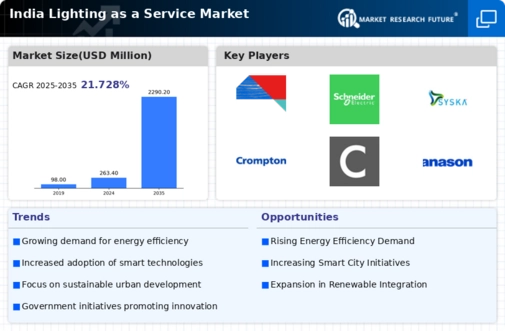Government Initiatives and Policy Support
Government policies in India are increasingly favoring the adoption of innovative lighting solutions, thereby propelling the lighting as-a-service market. Initiatives such as the National LED Programme aim to replace conventional lighting with LED technology, which is more energy-efficient. The government has allocated substantial funds for energy efficiency projects, with an estimated investment of $1.5 billion in the next five years. Such financial backing encourages businesses to explore lighting as-a-service models, which offer lower upfront costs and predictable expenses. This policy support not only fosters market growth but also aligns with India's commitment to reducing carbon emissions and promoting sustainable development.
Increased Awareness of Environmental Impact
There is a growing awareness among consumers and businesses in India regarding the environmental impact of traditional lighting solutions. This consciousness is driving the shift towards sustainable practices, including the adoption of energy-efficient lighting. The lighting as-a-service market promotes the use of LED technology and other sustainable lighting options. With an estimated reduction of 50% in energy consumption when switching to LED, the appeal of lighting as-a-service becomes evident. As more organizations commit to sustainability goals, the demand for such services is expected to rise, further propelling the market forward.
Technological Advancements in Lighting Solutions
Technological innovations are transforming the lighting landscape in India, significantly impacting the lighting as-a-service market. The advent of smart lighting technologies, such as IoT-enabled systems, allows for enhanced control and monitoring of lighting usage. These advancements not only improve energy efficiency but also provide users with valuable data on consumption patterns. The market for smart lighting is projected to grow at a CAGR of 25% over the next five years, indicating a strong shift towards integrated lighting solutions. As businesses and municipalities adopt these technologies, the lighting as-a-service market is likely to expand, offering tailored solutions that meet diverse lighting needs.
Rising Energy Costs and Demand for Cost Efficiency
The increasing cost of energy in India is driving businesses and consumers to seek more cost-effective lighting solutions. With energy prices rising by approximately 10% annually, the need for efficient lighting systems has become paramount. The lighting as-a-service market offers a viable solution by providing energy-efficient lighting without the burden of high initial investments. This model allows users to pay for lighting based on usage, which can lead to significant savings over time. As organizations and households look to manage their energy expenses better, the demand for lighting as-a-service is expected to grow, making it an attractive option for many.
Growing Urbanization and Infrastructure Development
The rapid urbanization in India drives the lighting as-a-service market. As cities expand, the demand for efficient and sustainable lighting solutions increases. Urban areas are projected to house over 600 million people by 2031, necessitating advanced lighting systems that can adapt to changing needs. The government has initiated various infrastructure projects, including smart city initiatives, which emphasize the importance of energy-efficient lighting. This trend indicates a shift towards integrated lighting solutions that not only enhance urban aesthetics but also reduce energy consumption. The lighting as-a-service market is likely to benefit from these developments. Municipalities seek to implement cost-effective and sustainable lighting solutions that align with urban growth strategies.

















Leave a Comment